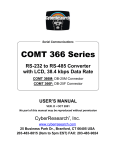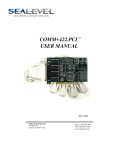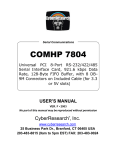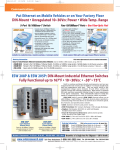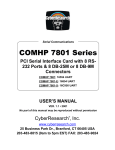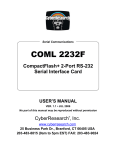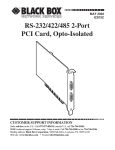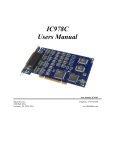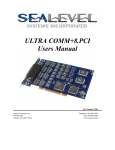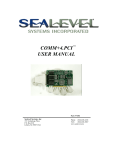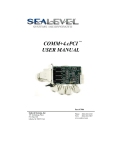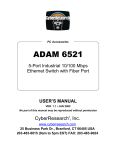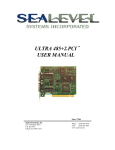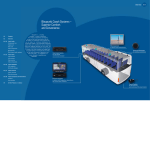Download CyberResearch COMHP 7404 User`s manual
Transcript
® Serial Communications COMHP 7404/-D25 PCI 4-Port Serial Interface Card, 460.8 kbps Data Rate, 128-Byte FIFO Buffer, with 4 DB-9M Cable or 4 DB-25M Cable (-D25 Model) USER’S MANUAL VER. 2.0C• Jun-10 No part of this manual may be reproduced without permission ® CyberResearch , Inc. Hwww.cyberresearch.com 25 Business Park Dr., Branford, CT 06405 USA 203-643-5000 (9 A.M. to 5 P.M. EST) FAX: 203-643-5001 ® CyberResearch Serial Communications COMHP 7404/-D25 ©Copyright 2010 All Rights Reserved. June 9, 2010 The information in this document is subject to change without prior notice in order to improve reliability, design, and function and does not represent a commitment on the part of CyberResearch, Inc. In no event will CyberResearch, Inc. be liable for direct, indirect, special, incidental, or consequential damages arising out of the use of or inability to use the product or documentation, even if advised of the possibility of such damages. This document contains proprietary information protected by copyright. All rights are reserved. No part of this manual may be reproduced by any mechanical, electronic, or other means in any form without prior written permission of CyberResearch, Inc. Trademarks “CyberResearch,” and “COMHP 7404/-D25,” are trademarks of CyberResearch, Inc. Other product names mentioned herein are used for identification purposes only and may be trademarks and/or registered trademarks of their respective companies. • NOTICE • CyberResearch, Inc. does not authorize any CyberResearch product for use in life support systems, medical equipment, and/or medical devices without the written approval of the President of CyberResearch, Inc. Life support devices and systems are devices or systems which are intended for surgical implantation into the body, or to support or sustain life and whose failure to perform can be reasonably expected to result in injury. Other medical equipment includes devices used for monitoring, data acquisition, modification, or notification purposes in relation to life support, life sustaining, or vital statistic recording. CyberResearch products are not designed with the components required, are not subject to the testing required, and are not submitted to the certification required to ensure a level of reliability appropriate for the treatment and diagnosis of humans. CyberResearch, Inc. 25 Business Park Drive Branford, CT USA iii P: (203) 643-5000; F: (203) 643-5001 www.cyberresearch.com ® COMHP 7404/-D25 Revision # iv CyberResearch Serial Communications Revision History Description Date of Issue 1.0 Initial Release May 1, 2007 2.0C Revision June 9, 2010 ©Copyright 2010 CyberResearch, Inc. ® CyberResearch Serial Communications COMHP 7404/-D25 Table of Contents INTRODUCTION ............................................................................................................................................1 OVERVIEW ..................................................................................................................................................................... 1 WHAT’S INCLUDED ........................................................................................................................................................ 1 FACTORY DEFAULT SETTINGS........................................................................................................................................ 1 CARD SETUP ................................................................................................................................................2 RS-485 ENABLE MODES ................................................................................................................................................ 2 Interface Mode Examples SW1 – SW4 (continued) .................................................................................................. 4 ADDRESS AND IRQ SELECTION ...................................................................................................................................... 4 ELECTRICAL INTERFACE SELECTION .............................................................................................................................. 5 CLOCK MODES ............................................................................................................................................................... 6 BAUD RATES AND DIVISORS FOR THE ‘DIV1’ MODE ...................................................................................................... 6 INSTALLATION .............................................................................................................................................7 OPERATING SYSTEM INSTALLATION .............................................................................................................................. 7 For Windows Users .................................................................................................................................................... 7 Other Operating Systems............................................................................................................................................ 7 SYSTEM INSTALLATION .................................................................................................................................................. 7 TECHNICAL DESCRIPTION...........................................................................................................................8 CONNECTOR PIN ASSIGNMENTS ..................................................................................................................................... 8 RS-422/485 (DB 9 Male)........................................................................................................................................ 8 RS-232 (DB-9 Male) .............................................................................................................................................. 8 CONNECTOR PIN ASSIGNMENTS ..................................................................................................................................... 9 RS-232, RS-422/485 (DB-37 Male) ....................................................................................................................... 9 SPECIFICATIONS ........................................................................................................................................10 ENVIRONMENTAL SPECIFICATIONS............................................................................................................................... 10 MANUFACTURING ........................................................................................................................................................ 10 POWER CONSUMPTION ................................................................................................................................................. 10 MEAN TIME BETWEEN FAILURES (MTBF)................................................................................................................... 10 PHYSICAL DIMENSIONS ................................................................................................................................................ 10 APPENDIX A - TROUBLESHOOTING ...........................................................................................................11 APPENDIX B - ELECTRICAL INTERFACE ...................................................................................................12 RS-232......................................................................................................................................................................... 12 RS-422......................................................................................................................................................................... 12 RS-485......................................................................................................................................................................... 13 APPENDIX C- ASYNCHRONOUS COMMUNICATIONS .................................................................................14 APPENDIX D - SILK-SCREEN .....................................................................................................................15 APPENDIX E - COMPLIANCE NOTICES ......................................................................................................16 FEDERAL COMMUNICATIONS COMMISSION STATEMENT .............................................................................................. 16 EMC DIRECTIVE STATEMENT ...................................................................................................................................... 16 CyberResearch, Inc. 25 Business Park Drive Branford, CT USA v P: (203) 643-5000; F: (203) 643-5001 www.cyberresearch.com ® CyberResearch Serial Communications COMHP 7404/-D25 TABLE OF FIGURES Figure 1- Switches SW1- SW4, RS-422.................................................................................................................................. 3 Figure 2 - Switches SW1- SW4, RS-485 ‘Auto’ Enabled, with ‘No Echo’ and the termination resistor in circuit......... 3 Figure 3 - Switches SW1- SW4, RS-485 ‘Auto’ Enabled, with ‘Echo’ and no termination resistor in circuit................ 3 Figure 4 - Switches SW1- SW4, RS-485 ‘RTS’ Enabled, with ‘No Echo’ and no termination resistor in circuit. ......... 4 Figure 5 - Switches SW1- SW4, RS-485 ‘RTS’ Enabled, with ‘Echo’ and no termination resistor in circuit. ............... 4 Figure 6 - Asynchronous Communications Bit Diagram ................................................................................................... 14 vi ©Copyright 2010 CyberResearch, Inc. ® CyberResearch Serial Communications COMHP 7404/-D25 Introduction Overview The CyberResearch® COMHP 7404 is a four channel RS-232/485/422 PCI Bus serial I/O adapter supporting data rates up to 460.8K bps. The RS-232 compatibility allows for connection to devices utilizing the RS-232 electrical interface, such as modems, data-entry terminals, and plotters. RS-422 provides excellent communications for long distance device connections up to 4000ft., where noise immunity and high data integrity are essential. RS-485 is optimized for ‘Multi-Drop’ or ‘Party-line’ operations selecting data from multiple peripherals (as many as 31 devices can be connected on an RS-485 bus). In both RS-485 and RS-422 modes, the card works seamlessly with the standard operating system serial driver. In RS-485 mode, our special auto-enable feature allows the RS-485 ports to be viewed by the operating system as a COM: port. This allows the standard COM: driver to be utilized for RS-485 communications. Our on-board hardware automatically handles the RS-485 driver enable. A quadracable splits the DB-37 connector on the backplate of the CyberResearch Adapter into four separate cables. On the COMHP 7404, these four cables terminate in DB-9M connectors. On the COMHP 7404-D25, these four cables terminate in DB-25M connectors. What’s Included The COMHP 7404 is shipped with the following items. If any of these items is missing or damaged, contact CyberResearch, Inc. • • • • COMHP 7404 Serial I/O Adapter SeaCOM Software Quadracable Cable providing 4 DB-9 connectors (COMHP 7404) Quadracable Cable providing 4 DB-25 connectors (COMHP 7404-D25) Factory Default Settings The COMHP 7404 factory default settings are as follows: Port # Port 1 Port 2 Port 3 Port 4 Clock DIV Mode 4 4 4 4 Enable Mode RS-422 RS-422 RS-422 RS-422 To install the COMHP 7404 using factory default settings, refer to Installation on page 7. CyberResearch, Inc. 25 Business Park Drive Branford, CT USA 1 P: (203) 643-5000; F: (203) 643-5001 www.cyberresearch.com ® CyberResearch Serial Communications COMHP 7404/-D25 Card Setup RS-485 Enable Modes RS-485 is ideal for multi-drop or network environments. RS-485 requires a tri-state driver that will allow the electrical presence of the driver to be removed from the line. The driver is in a tri-state or high impedance condition when this occurs. Only one driver may be active at a time and the other driver(s) must be tri-stated. The output modem control signal Request To Send (RTS) is typically used to control the state of the driver. Some communication software packages refer to RS-485 as RTS enable or RTS block mode transfer. One of the unique features of the COMHP 7404 is the ability to be RS-485 compatible without the need for special software or drivers. This ability is especially useful in Windows and other protected mode environments where the lower level I/O control is abstracted from the application program. This ability means that the user can effectively use the COMHP 7404 in an RS-485 application with existing (i.e. standard RS-232) software drivers. Switches SW1 - SW4 are used to control the RS-485 mode functions for the driver circuit. The selections are ‘RTS’ enable (silk-screen ‘RT’) or ‘Auto’ enable (silk-screen ‘AT’). The ‘Auto’ enable feature automatically enables/disables the RS-485 interface. The ‘RTS’ mode uses the ‘RTS’ modem control signal to enable the RS-485 interface and provides backward compatibility with existing software products. Position 3 (silk-screen ‘NE’) of these switches is used to control the RS-485 enable/disable functions for the receiver circuit and determine the state of the RS-422/485 driver. The RS-485 ‘Echo’ is the result of connecting the receiver inputs to the transmitter outputs. Every time a character is transmitted; it is also received. This can be beneficial if the software can handle echoing (i.e. using received characters to throttle the transmitter) or it can confuse the system if the software does not. To select the ‘No Echo’ mode select silk-screen position ‘NE’. Typically, each end of the RS-485 bus must have a line-terminating resistor (RS-422 terminates the receive end only). A 120-ohm resistor is across each RS-422/485 input in addition to a 1K-ohm pull-up/pull-down combination that biases the receiver inputs. Only the ends of an RS-485 network should have the 120-Ohm terminating resistor. Position 4 (silk-screen ‘T’) selects the presence of the 120-Ohm termination resistor across the input data pins (RX+/RX-). To add the termination select the ‘On’ position, to remove it select the ‘Off’ position. For RS-422/530/449 compatibility set all switches ‘Off’. Examples on the following pages describe some of the valid settings for SW1-SW4. 2 ©Copyright 2010 CyberResearch, Inc. ® CyberResearch Serial Communications COMHP 7404/-D25 Interface Mode Examples SW1 – SW4 ON OFF 1 2 3 4 AT RT NE T Figure 1- Switches SW1- SW4, RS-422 ON OFF 1 2 3 4 AT RT NE T Figure 2 - Switches SW1- SW4, RS-485 ‘Auto’ Enabled, with ‘No Echo’ and the termination resistor in circuit. ON OFF 1 2 3 4 AT RT NE T Figure 3 - Switches SW1- SW4, RS-485 ‘Auto’ Enabled, with ‘Echo’ and no termination resistor in circuit. CyberResearch, Inc. 25 Business Park Drive Branford, CT USA 3 P: (203) 643-5000; F: (203) 643-5001 www.cyberresearch.com ® CyberResearch Serial Communications COMHP 7404/-D25 Interface Mode Examples SW1 – SW4 (continued) ON OFF 1 2 3 4 AT RT NE T Figure 4 - Switches SW1- SW4, RS-485 ‘RTS’ Enabled, with ‘No Echo’ and no termination resistor in circuit. ON OFF 1 2 3 4 AT RT NE T Figure 5 - Switches SW1- SW4, RS-485 ‘RTS’ Enabled, with ‘Echo’ and no termination resistor in circuit. Address and IRQ selection The COMHP 7404 is automatically assigned resources by your motherboard BIOS. Only the I/O addresses may be modified by the user. Adding or removing other hardware may change the assignment of I/O addresses and IRQs. 4 ©Copyright 2010 CyberResearch, Inc. ® CyberResearch Serial Communications COMHP 7404/-D25 Electrical Interface Selection RS-232 E2 RS-422 E3 RS-232 E4 RS-422 E5 E6 RS-232 E6 E7 RS-422 E7 E8 RS-422 RS-232 Port 4 RS-232 RS-422 RS-232 RS-422 Port 1 Port 1 Port 2 E5 Port 2 E4 E8 RS-422/485 RS-232 E3 Port 3 E2 Port 3 Port 4 E1 RS-422 RS-422 E1 RS-232 Each port on the COMHP 7404 has the ability to be used in either RS-232 or RS-422/485. This is selectable via eight 24 pin DIP-shunts at E1-E8. Please use the following illustration to aid in the configuration of your electrical interface. RS-232 Figure 6 - Headers E1 - E4, Electrical Interface Selection CyberResearch, Inc. 25 Business Park Drive Branford, CT USA 5 P: (203) 643-5000; F: (203) 643-5001 www.cyberresearch.com ® CyberResearch Serial Communications COMHP 7404/-D25 Clock Modes The COMHP 7404 employs a unique clocking option that allows the end user to select from divide by 4, and divide by 1 clocking modes. These modes are selected at Header J1. To select the Baud rates commonly associated with COM: ports (i.e. 2400, 4800, 9600, 19.2, … 115.2K bps) place the jumper in the divide by 4 mode (silk-screen D4). To select the Baud rates above 115.2K select the divide by 1 mode (silk-screen D1). Baud Rates and Divisors for the ‘DIV1’ mode The following table shows some common data rates and the rates you should choose to match them if using the adapter in the ‘DIV1’ mode. For this Data Rate 1200 bps 2400 bps 4800 bps 9600 bps 19.2K bps 57.6 K bps 115.2 K bps 230.4K bps 460.8K bps Choose this Data Rate 300 bps 600 bps 1200 bps 2400 bps 4800 bps 14.4K bps 28.8K bps 57.6 K bps 115.2 K bps If your communications package allows the use of Baud rate divisors, choose the appropriate divisor from the following table: For this Data Rate 1200 bps 2400 bps 4800 bps 9600 bps 19.2K bps 38.4K bps 57.6K bps 115.2K bps 230.4K bps 460.8K bps 6 Choose this Divisor 384 192 96 48 24 12 8 4 2 1 ©Copyright 2010 CyberResearch, Inc. ® CyberResearch Serial Communications COMHP 7404/-D25 Installation Operating System Installation For Windows Users Start by choosing Install Software at the beginning of the CD. Choose Asynchronous COM: Port Software, SeaCOM. Other Operating Systems Refer to the appropriate section of the Serial Utilities Software. System Installation The COMHP 7404 can be installed in any of the PCI expansion slots and contains configuration options for each port that must be set for proper operation. 1. 2. 3. 4. 5. 6. 7. 8. Turn off PC power. Disconnect the power cord. Remove the PC case cover. Locate an available PCI slot and remove the blank metal slot cover. Gently insert the COMHP 7404 into the slot. Make sure that the adapter is seated properly. Replace the screw. Replace the cover. Install the Cable Connect the power cord. Installation is complete. CyberResearch, Inc. 25 Business Park Drive Branford, CT USA 7 P: (203) 643-5000; F: (203) 643-5001 www.cyberresearch.com ® CyberResearch Serial Communications COMHP 7404/-D25 Technical Description The CyberResearch® COMHP 7404 provides a PCI interface adapter with 4 RS-232/422/485 asynchronous serial ports for industrial automation and control applications. The COMHP 7404 utilizes the 16C864 UART. This chip features programmable baud rates, data format, interrupt control and industry leading 128-byte transmit and receive FIFOs. Connector Pin Assignments RS-422/485 (DB 9 Male) Signal GND TX + TXRTS+ RTSRX+ RXCTS+ CTS- RS-232 Name Ground Transmit Data Positive Transmit Data Negative Request To Send Positive Request To Send Negative Receive Data Positive Receive Data Negative Clear To Send Positive Clear To Send Negative Pin # 5 4 3 6 7 1 2 9 8 Name Ground Transmit Data Request To Send Data Terminal Ready Receive Data Clear To Send Data Set Ready Data Carrier Detect Ring Indicator Pin # 5 3 7 4 2 8 6 1 9 Mode Output Output Output Output Input Input Input Input (DB-9 Male) Signal GND TD RTS DTR RD CTS DSR DCD RI Mode Output Output Output Input Input Input Input Input Technical Note: Please terminate any control signals that are not going to be used. The most common way to do this is connect RTS to CTS and RI. Also, connect DCD to DTR and DSR. Terminating these pins, if not used, will help ensure you get the best performance from your adapter. 8 ©Copyright 2010 CyberResearch, Inc. ® CyberResearch Serial Communications COMHP 7404/-D25 Connector Pin Assignments RS-232, RS-422/485 (DB-37 Male) RS-422/485 RX+ RXTXTX+ GND RTS+ RTSCTSCTS+ Port # RS-232 DCD RD TD DTR GND DSR RTS CTS RI 1 2 3 4 37 36 35 34 33 18 17 16 15 10 11 12 13 14 29 30 31 32 28 27 26 25 24 9 8 7 6 1 2 3 4 5 20 21 22 23 Technical Note: Board connector is a DB-37M. Mating connector is a DB-37S, ACON P/N: D-37SK-SFS-T or equivalent. CyberResearch, Inc. 25 Business Park Drive Branford, CT USA 9 P: (203) 643-5000; F: (203) 643-5001 www.cyberresearch.com ® CyberResearch Serial Communications COMHP 7404/-D25 Specifications Environmental Specifications Specification Temperature Range Humidity Range Operating 0º to 50º C (32º to 122º F) 10 to 90% R.H. Non-Condensing Storage -20º to 70º C (-4º to 158º F) 10 to 90% R.H. Non-Condensing Manufacturing • All Systems Printed Circuit boards are built to U. L. 94V0 rating and are 100% electrically tested. These printed circuit boards are solder mask over bare copper or solder mask over tin nickel. Power Consumption Supply line Rating +12 VDC 60 mA -12 VDC 100 mA +5 VDC 620 mA Mean Time Between Failures (MTBF) Greater than 150,000 hours. (Calculated) Physical Dimensions Board length Board Height including Goldfingers Board Height excluding Goldfingers 10 6.5 inches 4.2 inches 3.875 inches (16.51 cm) (10.66 cm) (9.841 cm) ©Copyright 2010 CyberResearch, Inc. ® CyberResearch Serial Communications COMHP 7404/-D25 Appendix A - Troubleshooting SeaCOM Software is supplied with the CyberResearch adapter and will be used in the troubleshooting procedures. By using this software and following these simple steps, most common problems can be eliminated without the need to call Technical Support. 1. Identify all I/O adapters currently installed in your system. This includes your on-board serial ports, controller cards, sound cards etc. The I/O addresses used by these adapters, as well as the IRQ (if any) should be identified. 2. Configure your CyberResearch adapter so that there is no conflict with currently installed adapters. No two adapters can occupy the same I/O address. 3. Make sure the CyberResearch adapter is using a unique IRQ. While the CyberResearch adapter does allow the sharing of IRQs, many other adapters (i.e. SCSI adapters & on-board serial ports) do not. The IRQ is typically selected via an on-board header block. Refer to the section on Card Setup for help in choosing an I/O address and IRQ. 4. Make sure the CyberResearch adapter is securely installed in a motherboard slot. 5. When running DOS or Windows 3.x refer to the supplied SeaCOM software and this User Manual to verify that the CyberResearch adapter is configured correctly. This software contains a diagnostic program ‘SSD’ that will verify if an adapter is configured properly. This diagnostic program is written with the user in mind and is easy to use. 6. For Windows 95/98/ME/NT/2000, the diagnostic tool ‘WinSSD’ is installed in the SeaCOM folder on the Start Menu during the setup process. First find the ports using the Device Manager, then use ‘WinSSD’ to verify that the ports are functional. 7. Always use the diagnostic software when troubleshooting a problem. This will eliminate any software issues from the equation. CyberResearch, Inc. 25 Business Park Drive Branford, CT USA 11 P: (203) 643-5000; F: (203) 643-5001 www.cyberresearch.com COMHP 7404/-D25 ® CyberResearch Serial Communications Appendix B - Electrical Interface RS-232 Quite possibly the most widely used communication standard is RS-232. This implementation has been defined and revised several times and is often referred to as RS-232-C/D/E or EIA/TIA-232-C/D/E. It is defined as “Interface between Data Terminal Equipment and Data Circuit- Terminating Equipment Employing Serial Binary Data Interchange”. The mechanical implementation of RS-232 is on a 25-pin D sub connector. The IBM PC computer defined the RS-232 port on a 9 pin D sub connector and subsequently the EIA/TIA approved this implementation as the EIA/TIA-574 standard. This standard has defined as the “9-Position Non-Synchronous Interface between Data Terminal Equipment and Data CircuitTerminating Equipment Employing Serial Binary Data Interchange”. Both implementations are in wide spread use and will be referred to as RS-232 in this document. RS-232 is capable of operating at data rates up to 20K bps / 50 ft. The absolute maximum data rate may vary due to line conditions and cable lengths. RS-232 often operates at 38.4K bps over very short distances. The voltage levels defined by RS-232 range from -12 to +12 volts. RS-232 is a single ended or unbalanced interface, meaning that a single electrical signal is compared to a common signal (ground) to determine binary logic states. A voltage of +12 volts (usually +3 to +10 volts) represents a binary 0 (space) and -12 volts (-3 to -10 volts) denote a binary 1 (mark). The RS-232 and the EIA/TIA-574 specification define two types of interface circuits Data Terminal Equipment (DTE) and Data Circuit-Terminating Equipment (DCE). The Adapter is a DTE interface. RS-422 The RS-422 specification defines the electrical characteristics of balanced voltage digital interface circuits. RS-422 is a differential interface that defines voltage levels and driver/receiver electrical specifications. On a differential interface, logic levels are defined by the difference in voltage between a pair of outputs or inputs. In contrast, a single ended interface, for example RS-232, defines the logic levels as the difference in voltage between a single signal and a common ground connection. Differential interfaces are typically more immune to noise or voltage spikes that may occur on the communication lines. Differential interfaces also have greater drive capabilities that allow for longer cable lengths. RS-422 is rated up to 10 Megabits per second and can have cabling 4000 feet long. RS-422 also defines driver and receiver electrical characteristics that will allow 1 driver and up to 32 receivers on the line at once. RS-422 signal levels range from 0 to +5 volts. RS-422 does not define a physical connector. 12 ©Copyright 2010 CyberResearch, Inc. ® CyberResearch Serial Communications COMHP 7404/-D25 RS-485 RS-485 is backwardly compatible with RS-422; however, it is optimized for party line or multi-drop applications. The output of the RS-422/485 driver is capable of being Active (enabled) or Tri-State (disabled). This capability allows multiple ports to be connected in a multi-drop bus and selectively polled. RS-485 allows cable lengths up to 4000 feet and data rates up to 10 Megabits per second. The signal levels for RS-485 are the same as those defined by RS-422. RS-485 has electrical characteristics that allow for 32 drivers and 32 receivers to be connected to one line. This interface is ideal for multi-drop or network environments. RS-485 tri-state driver (not dual-state) will allow the electrical presence of the driver to be removed from the line. Only one driver may be active at a time and the other driver(s) must be tri-stated. RS-485 can be cabled in two ways, two wire and four wire mode. Two-wire mode does not allow for full duplex communication, and requires that data be transferred in only one direction at a time. For half-duplex operation, the two transmit pins should be connected to the two receive pins (Tx+ to Rx+ and Tx- to Rx-). Four wire mode allows full duplex data transfers. RS-485 does not define a connector pin-out or a set of modem control signals. RS-485 does not define a physical connector. CyberResearch, Inc. 25 Business Park Drive Branford, CT USA 13 P: (203) 643-5000; F: (203) 643-5001 www.cyberresearch.com ® CyberResearch Serial Communications COMHP 7404/-D25 Appendix C- Asynchronous Communications Serial data communications implies that individual bits of a character are transmitted consecutively to a receiver that assembles the bits back into a character. Data rate, error checking, handshaking, and character framing (start/stop bits) are pre-defined and must correspond at both the transmitting and receiving ends. Asynchronous communications is the standard means of serial data communication for PC compatibles and PS/2 computers. The original PC was equipped with a communication or COM: port that was designed around an 8250 Universal Asynchronous Receiver Transmitter (UART). This device allows asynchronous serial data to be transferred through a simple and straightforward programming interface. A start bit, followed by a pre-defined number of data bits (5, 6, 7, or 8) defines character boundaries for asynchronous communications. The end of the character is defined by the transmission of a predefined number of stop bits (usually 1, 1.5 or 2). An extra bit used for error detection is often appended before the stop bits. Idle state of line 5 to 8 Data Bits Odd, Even or Unused Remain Idle or next start bit 1 P BIT STOP 0 1 1.5 2 Figure 7 - Asynchronous Communications Bit Diagram This special bit is called the parity bit. Parity is a simple method of determining if a data bit has been lost or corrupted during transmission. There are several methods for implementing a parity check to guard against data corruption. Common methods are called (E)ven Parity or (O)dd Parity. Sometimes parity is not used to detect errors on the data stream. This is refereed to as (N)o parity. Because each bit in asynchronous communications is sent consecutively, it is easy to generalize asynchronous communications by stating that each character is wrapped (framed) by pre-defined bits to mark the beginning and end of the serial transmission of the character. The data rate and communication parameters for asynchronous communications have to be the same at both the transmitting and receiving ends. The communication parameters are baud rate, parity, number of data bits per character, and stop bits (i.e. 9600,N,8,1). 14 ©Copyright 2010 CyberResearch, Inc. ® CyberResearch Serial Communications COML 4232U/-D25 Appendix D - Silk-Screen 4.2" 6.5" CyberResearch, Inc. 25 Business Park Drive Branford, CT USA 15 P: (203) 643-5000; F: (203) 643-5001 www.cyberresearch.com ® CyberResearch Serial Communications COMHP 7404/-D25 Appendix E - Compliance Notices Federal Communications Commission Statement FCC - This equipment has been tested and found to comply with the limits for Class A digital device, pursuant to Part 15 of the FCC Rules. These limits are designed to provide reasonable protection against harmful interference when the equipment is operated in a commercial environment. This equipment generates, uses, and can radiate radio frequency energy and, if not installed and used in accordance with the instruction manual, may cause harmful interference to radio communications. Operation of this equipment in a residential area is likely to cause harmful interference in such case the user will be required to correct the interference at his own expense. EMC Directive Statement Products bearing low-voltage the CE Label fulfill the requirements of the EMC directive (89/336/EEC) and of the directive (73/23/EEC) issued by the European Commission. To directives, the following European standards must be met: obey these • EN55022 Class A - “Limits and methods of measurement of radio interference characteristics of information technology equipment” • EN55024 -'Information technology equipment Immunity characteristics Limits and methods of measurement' • EN60950 (IEC950) - “Safety of information technology equipment, including electrical business equipment” Warning This is a Class A Product. In a domestic environment this product may cause radio interference in which case the user may be required to take adequate measures. Always use cabling provided with this product if possible. If no cable is provided or if an alternate cable is required, use high quality shielded cabling to maintain compliance with FCC/EMC directives. 16 ©Copyright 2010 CyberResearch, Inc. ® CyberResearch Serial Communications COMHP 7404/-D25 Product Service Diagnosis and Debug CyberResearch, Inc. maintains technical support lines staffed by experienced Applications Engineers and Technicians. There is no charge to call and we will return your call promptly if it is received while our lines are busy. Most problems encountered with data acquisition products can be solved over the phone. Signal connections and programming are the two most common sources of difficulty. CyberResearch support personnel can help you solve these problems, especially if you are prepared for the call. To ensure your call’s overall success and expediency: 1) 2) 3) 4) 5) 6) Have the phone close to the PC so you can conveniently and quickly take action that the Applications Engineer might suggest. Be prepared to open your PC, remove boards, report back-switch or jumper settings, and possibly change settings before reinstalling the modules. Have a volt meter handy to take measurements of the signals you are trying to measure as well as the signals on the board, module, or power supply. Isolate problem areas that are not working as you expected. Have the source code to the program you are having trouble with available so that preceding and prerequisite modes can be referenced and discussed. Have the manual at hand. Also have the product’s utility disks and any other relevant disks nearby so programs and version numbers can be checked. Preparation will facilitate the diagnosis procedure, save you time, and avoid repeated calls. Here are a few preliminary actions you can take before you call which may solve some of the more common problems: 1) 2) 3) 4) Check the PC-bus power and any power supply signals. Check the voltage level of the signal between SIGNAL HIGH and SIGNAL LOW, or SIGNAL+ and SIGNAL– . It CANNOT exceed the full scale range of the board. Check the other boards in your PC or modules on the network for address and interrupt conflicts. Refer to the example programs as a baseline for comparing code. CyberResearch, Inc. 25 Business Park Drive Branford, CT USA 17 P: (203) 643-5000; F: (203) 643-5001 www.cyberresearch.com ® COMHP 7404/-D25 CyberResearch Serial Communications Intentionally Blank 18 ©Copyright 2010 CyberResearch, Inc. ® CyberResearch Serial Communications COMHP 7404/-D25 Warranty Notice CyberResearch, Inc. warrants that this equipment as furnished will be free from defects in material and workmanship for a period of one year from the confirmed date of purchase by the original buyer and that upon written notice of any such defect, CyberResearch, Inc. will, at its option, repair or replace the defective item under the terms of this warranty, subject to the provisions and specific exclusions listed herein. This warranty shall not apply to equipment that has been previously repaired or altered outside our plant in any way which may, in the judgment of the manufacturer, affect its reliability. Nor will it apply if the equipment has been used in a manner exceeding or inconsistent with its specifications or if the serial number has been removed. CyberResearch, Inc. does not assume any liability for consequential damages as a result from our products uses, and in any event our liability shall not exceed the original selling price of the equipment. The equipment warranty shall constitute the sole and exclusive remedy of any Buyer of Seller equipment and the sole and exclusive liability of the Seller, its successors or assigns, in connection with equipment purchased and in lieu of all other warranties expressed implied or statutory, including, but not limited to, any implied warranty of merchant ability or fitness and all other obligations or liabilities of seller, its successors or assigns. The equipment must be returned postage prepaid. Package it securely and insure it. You will be charged for parts and labor if the warranty period has expired. Returns and RMAs If a CyberResearch product has been diagnosed as being non-functional, is visibly damaged, or must be returned for any other reason, please call for an assigned RMA number. The RMA number is a key piece of information that lets us track and process returned merchandise with the fastest possible turnaround time. PLEASE CALL FOR AN RMA NUMBER! Packages returned without an RMA number will be refused! In most cases, a returned package will be refused at the receiving dock if its contents are not known. The RMA number allows us to reference the history of returned products and determine if they are meeting your application’s requirements. When you call customer service for your RMA number, you will be asked to provide information about the product you are returning, your address, and a contact person at your organization. Please make sure that the RMA number is prominently displayed on the outside of the box. • Thank You • CyberResearch, Inc. 25 Business Park Drive Branford, CT USA 19 P: (203) 643-5000; F: (203) 643-5001 www.cyberresearch.com ® COMHP 7404/-D25 CyberResearch Serial Communications Intentionally Blank 20 ©Copyright 2010 CyberResearch, Inc. CyberResearch, Inc. 25 Business Park Drive Branford, CT 06405 USA P: (203) 643-5000; F: (203) 643-5001 www.cyberresearch.com




























